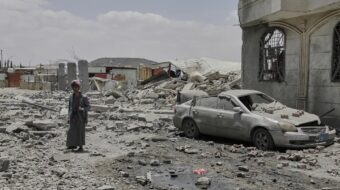
Cuba
Photographs by Jack Kenny
Corazon Press, 2005
Hardcover, 120 pp., $65
The island nation of Cuba is one of the most fabled places on earth. Just the mention of its name evokes a plethora of images, from steamy salsa music and the world’s finest cigars to the vintage American cars on the streets of Havana and the ubiquitous revolutionary image of Ché Guevara. The Cuban Revolution is a source of hope and pride for many in Latin America and a thorn in the side of others who wish for a return to the days when U.S. business interests reigned supreme.
Depending on who you talk to, you will hear of the highest literacy rates in the region or of draconian food-rationing; a highly effective health care system or of rampant political repression.
A visit to Cuba reveals a complex reality deeply affected both by the U.S embargo against the country, which limits access to basic medicines and other supplies, and the rapid influx of tourist dollars from Europe and Canada, which challenge the socialist example.
Cuba is many things to many people, including the Cubanos themselves. For some, it is an outward-looking culture, obsessed by the perceived riches and excesses of capitalist economies, while for others it is possessed of a proud heritage and stands as a model of defiance and sustainability in a world gone awry.
See for yourself
In the early 1980s I was deeply moved by the photographs of Susan Meiselas chronicling the triumph of the Nicaraguan Revolution, which she was clearly enamored with. When I was lucky enough to see her present the work in person, she implored the people in the audience not to take her word on the matter but to “go see for yourself.”
Having had the good fortune to spend time in Cuba in the late 1990s studying their cutting-edge organic agriculture program, I would suggest that anyone with a genuine interest in the country try to do the same, although a recent U.S. crackdown on travel to the Cuba has made it harder than ever for U.S. citizens to go and “see for themselves.”
Short of being able to travel to Cuba, we can “visit” this beautiful and inspiring country through the eyes and hearts of others. A recent book of photographs simply titled “Cuba” by Jack Kenny is useful in this regard. Kenny’s passion for the people of Cuba and for photography as a means of communication are clearly evident in his carefully executed and richly reproduced black and white images that are the result of his more than 30 trips to the country. While “Cuba” is not a detailed survey of the island and its culture by any means, it is a portal into the lives of a people through a distinct and passionate perspective.
‘Around the island’
Kenny begins his book with a journey that takes us “Around the Island” with a selection of photographs from various provinces, touching on numerous themes. Most are portraits, either intimate or environmental, with the occasional landscape to set the scene. Many of his portraits are piercing, eyes locked on the lens, as if the person is looking through to communicate something of their reality with the viewer.
The pictures are striking on many levels and introduce us to the themes that run through this book. We see families, elders, religion, agriculture, architecture, youth and, of course, cigars, vintage cars and revolutionary imagery.
Kenny’s choice of a picture to start the book is indicative of not only what is to come in the pages that follow, but also points to the inherent dichotomy of the project. Three women, a baby and a man stand in a deteriorating but solid doorway. We know that it is a family because the title tells us so, but it is unclear as to the details. The picture is ripe with ambiguity.
Other pictures are less ambiguous but still open to the viewer’s stance: A man toils at a lathe in a rustic shop; a patched up ’50s vintage Cadillac drives in front of a crumbling, yet beautiful, Greek Revival-style home; boys play a game of chess on a tattered “board” sitting on the stoop of a rundown building; a man tills a field with a team of oxen and a makeshift harrow.
Those of us sympathetic to the Cuban project read these richly detailed images as a record of the fortitude, resilience, ingenuity and pride of a people who have figured out how to do more with less and see the glass as half full. Taken a step further, the Cubans in these pictures could be seen as world leaders in sustainability as they recycle products and practice sustainable agriculture.
‘Playa Baracoa’
The second and shortest section of the book, “Playa Baracoa,” has only 13 photographs, but does much to tell the recent history of this seaside town and Cuba in general. Kenny photographed Playa Baracoa before and after Hurricane Ivan, which dealt the former summer resort of rich Cubans a direct hit. Vestiges of the town’s former opulence are evident in a few of the pictures: an elaborate and detailed stone foundation, a beautifully tiled floor, and a whitewashed summer cottage interior festooned with starfish and hanging nets, all speak to an earlier time when this town was a summer haven for the city’s wealthy.
Beyond this vestige of a storied past, numerous portraits speak to a new reality. A boy on a mountain bike sports a pair of stylish sunglasses and gleaming white pair of basketball sneakers, two young girls clad in bathing suits and flip flops smile by his side, a well groomed street spreads out behind them. Other more intimate portraits might be of families anywhere expressing the joy of a summer vacation, albeit in less prosperous times, posing in front of a weathered facade or swimming off of a crumbling breakwater.
The most striking image of this section has little to do with the seaside culture, but is one of the rare images in this book that speaks to the artistic vitality of Cuba. A young girl in a wheelchair, leg in a cast, sits in front of her brother’s painting. She seems to emerge from the artwork itself, which evokes the highly regarded work of painters like Keith Haring and Jean Michel Basquiat. A close look at the photograph reveals that the artist’s “canvas” is actually the side of a building.
Havana life
The final and by far the most extensive section of “Cuba” documents the street life of Havana, arguably one of the most photogenic cities on earth. Its colonial architecture and bustling streets have engaged countless documentary photographers, and Kenny follows in that tradition with a broad overview of the activities that take place there, interspersed with some penetrating portraits.
While there are a few images in this section that stand out as powerful statements in their own right (his “Diving on the Malecon” is among the best, evoking the work of the great Hungarian photographer Martin Munkacsi), it is the sum of the pictures presented that paint a portrait of the city in all its vibrancy.
In Kenny’s Havana, vintage cars share the road with bicycles, and laundry hangs to dry in brilliant whiteness. Groups of people gather to play games, vendors vend, hair is cut, fingernails painted, elaborate tattoos revealed. Lovers stroll Kenny’s streets. Except for the city’s stunning backdrop, this explosion of life could be anywhere, which may be Kenny’s point.
Power of photography
Contrary to popular belief in the U.S., the people of Cuba are mostly a happy and vital lot, going about the business of life much as everyone else. If there is repression, it’s not visible in these streets. If there is poverty, it’s not of the wrenching kind that we see in the war-torn parts of the world that dominate our news. Kenny’s Cuba is full of hope, inspiration and beauty.
If we wonder for a minute where his sympathies lie, we need only to turn to the last two pages of the book. On the first of these two pages a “revolutionary” proudly displays a tattoo of Ché that covers the better part of his chest. The following and final page of the book is a portrait of Alberto “Korda” Diaz, the photographer who made the iconic photograph of Ché, a potent symbol of revolution, from which the tattoo and millions of other reproductions have been made.
Whether you find yourself with the opportunity to visit Cuba and “see for yourself” or not, Jack Kenny’s “Cuba” has much to reveal about this glorious island and its people. It also speaks of the power of photography to communicate, albeit subjectively, across boundaries of all kinds, whether physical, cultural or political.
Scott Vlaun (scott@moosepondarts.com) is a writer, photographer and co-founder of Moose Pond Arts and Ecology in Otisfield, Maine.









